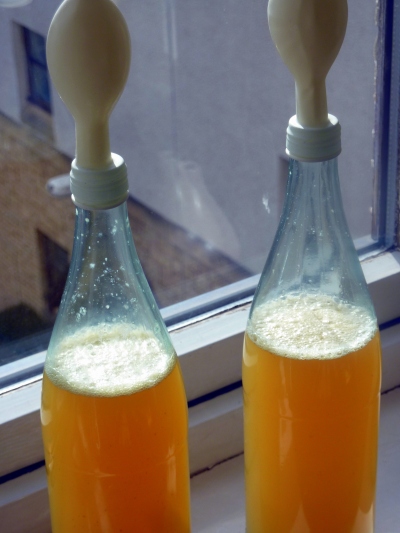I have wanted to try brewing something for sometime, and as both mead and honey are particular interests of mine, mead seemed the obvious thing to try for myself. However, the usual methods employed to brew mead at home require at a minimum certain brewing equipment that I currently lack. Standard methods include sterilizing the honey and water used, adding a specific brewing yeast, and carrying out the fermentation in a specialised brewing vessel fitted with an air lock.
Lacking any of these, and inspired by The Art of Fermentation by Sandor Katz, I decided to try a different approach using the wild yeasts naturally found in honey. I am also rather curious as to how people in ancient times produced their mead, after all it was mostly likely one of the first alcoholic beverages, and they surely had a certain lack of specialised brewing equipment.
While honey itself is remarkably resistant to microbial action, this property is dependent on the water content remaining low, and as soon as the honey is diluted with water the dormant wilds present in the honey reawaken and soon get to work converting the honey sugar into alcohol. This of course depends on the honey still being in a raw state and not heat treated during its processing. The random selection of wild yeast strains and other assorted bacteria present in unheated honey naturally make this rather a shot in the dark in terms of how the resulting mead may turn out. But as I only wish to make a small amount there seems little loss for me to give it a try.
In his book Sandor recommends a ratio of four parts water to one part honey as a good starting point. Looking for a good honey to use I decided on the Organic Forest Honey from Zambia as this should not have been heat treated and also happens to be the cheapest raw honey available to me for an initial experiment. Dissolving a 250 ml jars worth of honey into 1 L of water took some time and a quite a lot of stirring. When eventually dissolved I put it into a couple of glass Acqua Panna mineral water bottles for the brewing. As I bought bottles for the purpose the mineral water was using to make the mead. A party balloon with a pinprick hole in the top makes a very simple airlock, allowing any pressure inside to escape while keeping air out.
It took a few days of shaking the honey and water up each day before the yeast seemed to become active but now liquid has been bubbling away well for about a week with the balloons on top inflated with carbon dioxide from the fermentation. I have read that this initial fermentation will continue for a a couple of weeks during which time all the glucose in the honey is rapidly fermented. When that slows down the mead can then be bottled where it continues to slowing ferment the remaining fructose becoming drier and less sweet with increased aging.
While the outcome cannot be predicted, I await the results with hopeful expectations. It will be interesting to see the results of those yeasts so recently inhabiting the wild Zambian forests.

Very cool! Be sure to check out The Meadery as well:
http://www.TheMeadery.net
LikeLike
Stephen Howard Buhner’s book Sacred and Healing Beers has a lot of info on brewing practices.
LikeLike
Hm, I wonder, how did this turn out? 🙂
LikeLike